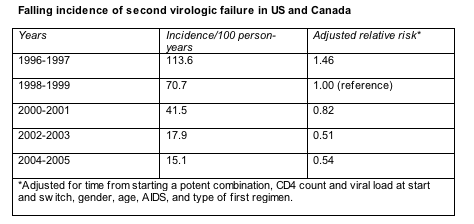 |
 |
 |
| |
Dramatic Drop in Second-Line Antiretroviral Failures Across US and Canada
|
| |
| |
15th Conference on Retroviruses and Opportunistic Infections
February 3-6, 2008
Boston
Mark Mascolini
Failure rates with regimens begun after a first virologic failure dropped smartly after 1996-1997 across the US and Canada, according to results from the North American AIDS Cohort Collaboration on Research and Design (NA-ACCORD) [1]. And researchers compiled the results before the newest antiretroviral classes--CCR5 antagonists and integrase inhibitors--became available.
A higher viral load and lower CD4 count at second failure, and clinical AIDS at that point, independently raised the risk of death.
Richard Moore (Johns Hopkins University, Baltimore) and coworkers amassed data on 33,381 people from 16 cohorts representing 60 sites. Everyone began a potent antiretroviral regimen from 1996 through 2005. That regimen failed with a viral load above 1000 copies in 15,457 people, 9337 of whom switched more than nucleosides in their regimen. After the backup regimen began, 5057 people endured a second virologic failure, and Moore had follow-up data on 4242 of them. After the second failure, he counted 1126 deaths in 14,485 person-years.
About one quarter of cohort members got infected by injecting drugs, 85% were men, and 31% had no single- or double-drug experience when they began a potent combination. Median CD4 count stood at 222 at second failure and median viral load at 15,723. A median of 2.9 years elapsed between the start of a first potent regimen and second failure.
Incidence of second virologic failure dropped steeply over the study period (table). With 1998-1999 as the reference years, risk of second failure fell almost 20% in 2000-2001, and about 50% in 2002-2003 and 2004-2005 (table).
The incidence in 98'-99' was 70.7/100 person-years. With the years of 1998-1999 as a reference In 1996-1997 the incidence was higher: 113.6 person-years (adjusted relative risk 1.46). So the years of early HAART had a 46% higher risk compared to 1998-1999. But in subsequent years the risk increasingly decreased from an incidence of 41.5 in 2000-2001 (adjusted relative risk 0.82, decline of 18% compared to 1998-1999 and a much bigger decline from 1996-1997) to in 2002-2003 where the incidence was 17.9/100 person-years (adjusted relative risk of 0.51, so this fell about 40% from 2000-2001 and almost 100% from 1996-1997; and the rate in 2004-2005 was 15.1/100 person-years with an adjusted relative risk of 0.54). The relative risk was adjusted for time from starting a potent combination, CD4 count and viral load at start and switch, gender, age, AIDS, and type of first regimen.

After the second virologic failure, median survival stretched to 7.1 years (95% confidence interval [CI] 6.5 to 7.8). Lower CD4 count, higher viral load, and AIDS at second failure independently raised the death risk:
· Compared with a CD4 count above 200 at second failure, a count of 50 to 200 upped the death risk 81% (relative hazard [RH] 1.81, 95% CI 1.55 to 2.11, P < 0.01), and a count under 50 more than quadrupled the risk (RH 4.24, 95% CI 3.54 to 5.09, P < 0.001).
· Compared with a viral load below 10,000 copies, a load of 10,000 to 100,000 made death 29% more likely (RH 1.29, 95% CI 1.07 to 1.47, P < 0.01) and a load above 100,000 nearly doubled the death risk (RH 1.93, 95% CI 1.61 to 2.31, P < 0.001).
· Clinical AIDS at second failure made death 29% more likely (RH 1.29, 95% CI 1.13 to 1.48, P < 0.001).
Factors that did not affect mortality in this analysis were gender, injecting drug use, antiretroviral experience before potent therapy, type of first regimen, and baseline viral load or CD4 count. When Moore restricted this analysis to people with no antiretroviral experience when they began their first regimen, he found largely similar results. Again, only lower CD4 count, higher viral load, and clinical AIDS at second failure independently correlated with death.
The NA-ACCORD team urged clinicians to address second virologic failure swiftly in people with the death predictors they identified.
Reference
1. Deeks S, and North American AIDS Cohort Collaboration on Research and Design (NA-ACCORD) of the IeDEA. Trends in second virologic failure and predictors of subsequent mortality among ART-experienced patients: North American experience. 15th Conference on Retroviruses and Opportunistic Infections. February 3-6, 2008. Boston. Abstract 41.
|
| |
|
 |
 |
|
|